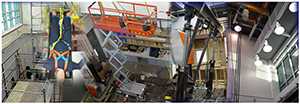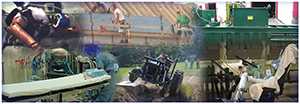MACHINE SAFETY
NIOSH is home to two labs for machine safety research. Continue reading to learn more about their capabilities.
High Bay Laboratory
 Containing a 37-foot-high ceiling with an overhead catwalk, the NIOSH High Bay Laboratory is dedicated to research efforts in reducing fall-related injuries and improving the safety of large equipment used in industrial, construction, and agricultural applications. Test equipment includes a 5-ton bridge crane, a test bed, an MTS hydraulic power supply and actuator system, and a research manikin.
Containing a 37-foot-high ceiling with an overhead catwalk, the NIOSH High Bay Laboratory is dedicated to research efforts in reducing fall-related injuries and improving the safety of large equipment used in industrial, construction, and agricultural applications. Test equipment includes a 5-ton bridge crane, a test bed, an MTS hydraulic power supply and actuator system, and a research manikin.
The laboratory, which was developed in 1995, has been used for projects related to improving:
- scaffolding stability
- ladder safety
- design of tractor rollover protective structures
- tension/compression testing of fabricated protective structures
- ingress/egress safety for construction equipment.
Facts about our test equipment:
- The hydraulic actuators can produce up to 20,000 pounds of force.
- The Advanced Dynamic Anthropomorphic Manikin (ADAM) is representative of a 95th percentile Air Force male. ADAM contains a sophisticated and ruggedized onboard data acquisition system, joint sensors, three tri-axial accelerometers (located in the head, chest, and lower torso), and two load cells (located at the neck and lower spine). ADAM has been used in a series of tests on the biodynamic forces that protective equipment and the human body would experience during free-fall and rapid deceleration while wearing fall-restraint equipment.
- Equipped with protective rails, a catwalk provides a mechanism for studying human perception and responses at heights.
Safety Engineering Laboratory
 The Safety Engineering Laboratory is the focal point for testing instrumentation and study procedures for field-based safety engineering studies. It consists of several pieces of equipment used for cab design and reverse engineering. Two FARO arms (6-foot and 8-foot) along with two test bucks (one to simulate a long-haul truck cab, the other to simulate a fire engine cab) measure cab accommodation for individual subjects. Both test bucks have all major cab operational components, including the clutch, brake, accelerator, gear shift, steering wheel, side-view mirrors, and driver’s seat – all of which can be adjusted to fit a specific subject.
The Safety Engineering Laboratory is the focal point for testing instrumentation and study procedures for field-based safety engineering studies. It consists of several pieces of equipment used for cab design and reverse engineering. Two FARO arms (6-foot and 8-foot) along with two test bucks (one to simulate a long-haul truck cab, the other to simulate a fire engine cab) measure cab accommodation for individual subjects. Both test bucks have all major cab operational components, including the clutch, brake, accelerator, gear shift, steering wheel, side-view mirrors, and driver’s seat – all of which can be adjusted to fit a specific subject.
Previously tested study procedures include:
- paper baler jam alert system testing
- field testing of farm tractor roll-over protective volume
- Page last reviewed: April 12, 2017
- Page last updated: April 12, 2017
- Content source:
- National Institute for Occupational Safety and Health Division of Safety Research


 ShareCompartir
ShareCompartir